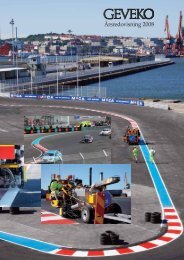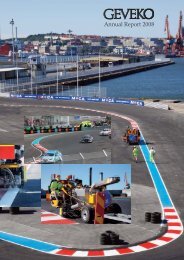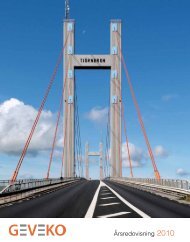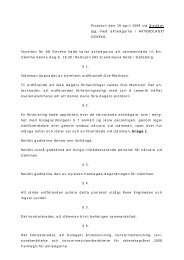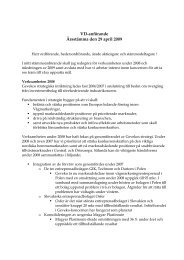PDF Document 2.46 MB - Geveko
PDF Document 2.46 MB - Geveko
PDF Document 2.46 MB - Geveko
Create successful ePaper yourself
Turn your PDF publications into a flip-book with our unique Google optimized e-Paper software.
Financial Reports / Accounting and valuation principlesPremiums received in connection with theissue of call options are stated as liabilitiesuntil the option has definitely been closed.Changes in the market value of options arestated under “Income from Securities”. Theoptions are stated as income when theymature.Premiums paid in connection with thepurchase of put options are stated togetherwith the value of the share to which theoption relates. Changes in the market valueof options are stated under “Income fromSecurities”. The options are stated as a costwhen they mature.Current assets and liabilitiesAssets are classified as current assets whenthey are expected to be sold or realised within12 months or are assets comprising liquidfunds. All other assets are classified as fixedassets.Liabilities are classified as currentwhen they are expected to be settled or tomature within 12 months. All other liabilitiesare classified as long-term assets.Income tax IAS 12Industrial OperationsStated income tax includes tax that is to bepaid or received in respect of the reportingyear, adjustments to previous years’ tax, andchanges in deferred tax.All tax liabilities/receivables are valuedat nominal amounts in accordance with thetax rules and at the tax rates that have beendecided on or announced and that will mostprobably be applied.The tax effects associated with items inprofit and loss accounts are also stated in theprofit and loss account. The tax effects ofitems that are not stated in the profit andloss account are taken direct against equity.Deferred tax is calculated using thebalance sheet method on all periodisationdifferences arising between the book andfiscal values of assets and liabilities. Thesedifferences largely arise as a result of transfersto untaxed reserves, excess values arisingupon consolidation, and taxable losses.Deferred tax receivables in respect ofloss allowances or other future deductionsfor tax purposes are stated to the extent thatfactors exist that make it likely that the itemcan be deducted against a taxable surplus inthe future.Deferred tax liabilities in respect ofperiodisation differences that are attributableto investments in subsidiary and associatecompanies are not stated in <strong>Geveko</strong>’s consolidatedfinancial statements when theprofits are not liable to taxation or whenthe parent company can determine when theperiodisation differences are to be re-entered.Parent companyFor purposes of taxation AB <strong>Geveko</strong> hasinvestment trust status, from which it followsthat the parent company is not liable totaxation on capital gains on sales of shares.Instead the company takes up in its taxreturn, income at a standard level of 1.5% ofthe opening market value of its listed shares.Dividends received and interest income areliable for taxation. Interest costs and managementcosts as well as dividends paid aredeductible costs.Intangible fixed assetsIAS 38, IAS 36, IAS 23Research and development: Expenditure onresearch is stated as a cost when it is in -curred. Expenditure on development projects(attributable to the development and testingof new or improved products) is capitalisedas an intangible fixed asset to the extent thatthis expenditure is expected to generatefinancial benefits in the future and the acquisitionvalue of the asset can be determinedreliably. Other development expenditure isstated as a cost as it is incurred. Developmentcosts that have once been taken into theprofit and loss account are not capitalised asassets in later periods. Interest on capitalborrowed to finance a development projectis not included in the acquisition value.The parent company has no expenditureon research and development.Capitalised development costs aredepreciated linearly over the period that theexpected benefits are estimated to accrue tothe Group, and from the date when commercialproduction starts. The depreciation perioddoes not exceed five years. The depreciationis stated in the profit and loss account underResearch and Development costs.Goodwill: Goodwill is the amount bywhich the acquisition value exceeds theactual value of the Group’s interest in anacquired subsidiary company’s net assets atthe time of acquisition. Goodwill is testedannually for impairment and stated at itshistoric cost less accumulated write-downs.Capital gains or losses on the divestmentof a unit include the residual book value ofthe goodwill relating to the divested unit.<strong>Geveko</strong> had no goodwill in its consolidatedfinancial statements for 2006 or 2007.Other intangible assets: Expenditure onacquired patents, brand names, licences andcustomer contracts is capitalised and depreciatedlinearly over the contractual economiclife, normally no more than five years. Thedepreciation is included in the profit and lossaccount under Cost of sold products.Write downs in the value of intangiblefixed assets: When there is an indication thatthe value of an asset has diminished an estimateis made of the recoverable value of theasset. In the event that this value falls shortof the book value of the asset, the asset isimmediately written down to that value.Tangible fixed assetsIAS 16, IAS 36, IAS 23Tangible fixed assets are stated at theirhistoric cost less depreciation. Additionalexpenditure that leads to an increase in thefuture financial benefits associated with theasset is capitalised as an asset, while anyremaining undepreciated residual value ofthe replaced equipment is stated as a cost.Expenditure on repairs and maintenance isstated as a cost. The cost of borrowing inconnection with investments is not capitalised.The Group has no managementproperty.Tangible fixed assets are depreciatedsystematically over the estimated utility periodof the asset. In applicable cases, componentdepreciation is used; this means that eachsignificant part of a fixed asset is depreciatedaccording to a separate plan. When determiningthe depreciable value of the asset,the residual value of the asset is taken intoaccount where relevant. Linear depreciationis used for all types of tangible fixed asset.The following depreciation periods are used:Buildings andland installations20-50 yearsMachinery andother technical facilities 5-15 yearsEquipment, toolsand installations5-15 yearsComputers3-5 yearsIn the event that the book value of an assetexceeds its estimated recoverable value theasset is immediately written down to itsrecoverable value. The recoverable value isthe higher of the asset’s net sales value andits utility value. The utility value is the discountedvalue of the asset’s future cash flow.If the contribution of the asset to the cashflow cannot be identified a review is insteadmade of whether any write-down in thevalue of the cash-generating unit is needed.Provisions, contingent liabilitiesand contingent assets IAS 37Provisions are liabilities that are uncertain inrespect of amount or time. They shall bestated when the company has made a formalor informal undertaking that results in anoutflow of resources that can be reliably estimated.An informal undertaking has beenmade when the company, from practice or ina public statement, has explicitly given anundertaking. Transfers to restructuringreserve may only be made when there is anundertaking and a detailed plan for therestructuring. The reserve may only be used61



